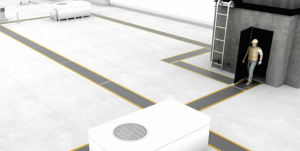 The question, “What is TPO roofing versus EPDM roofing?” is not an uncommon one asked in the commercial roofing industry. The short answer is that there are two kinds of synthetic rubber roofing membranes used widely in commercial roofing systems to seal roofs. Which material is better is another question, with the application of one or the other depending on several external factors.
The question, “What is TPO roofing versus EPDM roofing?” is not an uncommon one asked in the commercial roofing industry. The short answer is that there are two kinds of synthetic rubber roofing membranes used widely in commercial roofing systems to seal roofs. Which material is better is another question, with the application of one or the other depending on several external factors.
Understanding Roofing Requirements
Unlike the steeply pitched roofs of most residential housing, as a matter of design and functionality, most commercial roofing generally has flat or very low-sloped roofs that require various sealing requirements. Due to this design, in the commercial roofing sector, single-ply membrane roofing is the most frequently used material to meet sealing requirements.
Single-ply membrane roofing materials consist of elastomeric compounds, a type of polymer more commonly referred to as synthetic rubber. The compounds are combined with other binding agents, manufactured in sheets of varying widths and lengths, and rolled for shipping and delivery. The single-ply membrane sheets then are easily unrolled on roofs to be mechanically fastened, ballasted, or chemically adhered to the surface.
The two main categories in single-ply roofing material composition, as classified by the National Roofing Contractors Association (NRCA), are those membranes made of thermoplastic and thermoset polymers. The two main types of single-ply membrane roofing used in commercial applications are TPO (Thermoplastic Polyolefin) and EPDM (Ethylene Propylene Diene Monomer). As the name implies, the former is categorized as a thermoplastic, and the latter is a thermoset. The main material difference is that thermoplastics have a lower melting point than thermoset plastics and can be remolded or reshaped after installation. Though thermoset plastics can withstand higher temperatures and allow for flexible design options, they cannot be reformed or reshaped once set.
What Is TPO Roofing?
TPO roofing is a single-ply thermoplastic membrane. A synthetic rubber, it is a blend of ethylene-propylene and polypropylene with scrim fillers such as talc, fiberglass, and carbon fiber that reinforce and improve its stability, strength, and performance but also add flexibility. TPO was first introduced in Europe during the 1980s and in the US since the 1990s. Today it is considered one of the fastest-growing segments of the commercial roofing market. That, in large part, is because TPO was developed to combine some of the best qualities of other roofing systems such as EPDM and PVC.
TPO is a lightweight, puncture-resistant material. It has a laminated quality, meaning each side of the sheet has different material characteristics. The top side, the default white color, provides wear resistance, while the bottom, usually gray or a darker color, consists of the reinforced filler material. With its UV-resistant and reflective properties, TPO is valued for its energy efficiency, providing reduced cooling costs and energy savings for facilities when temperatures are high. TPO is typically available in thicknesses of 45 mils, 60 mils, and 90 mils. It is relatively easy to install and can be mechanically attached or adhered to by glue or adhesive.
Depending on the conditions—e.g., environmental, maintenance, climate—TPO roof life expectancy can stretch from 22-30 years on the high end, with conservative estimates between 15-20 years. A TPO roof membrane can last upwards of 20 years, with manufacturer warranties on installation typically lasting up to 30 years. When installed according to manufacturer specifications, TPO receives high wind ratings.
What Is EPDM?
Often referred to as “rubber roof,” EPDM is a durable thermoset, single-ply synthetic rubber roofing membrane that’s been in use for 60 years. As the name suggests, EPDM is made from ethylene and propylene, derived from oil and natural gas. The material is available in black or white and comes in a wide variety of widths that range from 7.5 feet to fifty feet, in thicknesses of 45 and 60 mils.
With an average service life of approximately 25-30 years, EPDM has much to offer. It provides high resistance to wind, hail, offers UV resistance, thermal shock, and protection from extreme temperatures. For installation, EPDM can be mechanically attached, ballasted, or fully adhered, with the seams sealed with liquid adhesives or specially formulated tape. It is an economical choice over TPO, which is more expensive than EPDM, with the latter lasting longer.
Nevertheless, as TPO is a more recent roofing material, it hasn’t stood the test of time compared to the decades that EPDM has. Though the material cost for TPO is higher, its ease of installation is quicker and less disruptive, with the resulting labor costs lower. It offers exceptional waterproofing over large surfaces, and its UV reflective properties provide a “cool roof” effect that helps keep building cooling and heating costs balanced with long-term savings over time. Finally, because of its lightweight, the excellent protection it provides does not place undue stress on buildings.
Contact the Experts at Manufacturer’s Rubber & Supply
Determining which roofing solution is a better choice, EPDM or TPO, may come down to several external factors. Temperature extremes, rain and snow, and geographic location can affect each roofing system’s longevity, durability, and performance. Ultimately, roofing contractors will have to decide which system best serves the project’s demands before choosing between EPDM or TPO.
At Manufacturer’s Rubber and Supply, we offer years of expertise and look forward to helping you find industrial rubber products that will best suit your needs. To learn more, contact us or shop our TPO roof walkways below!


